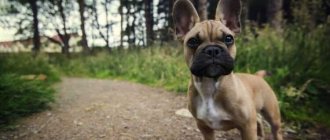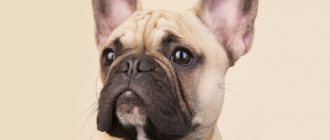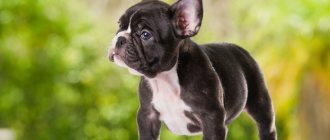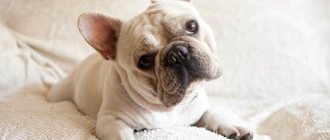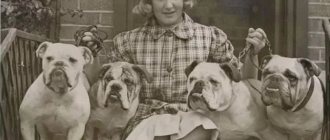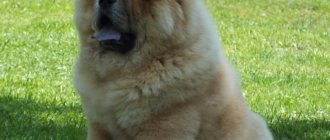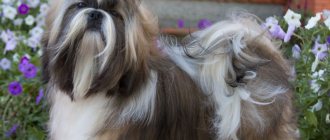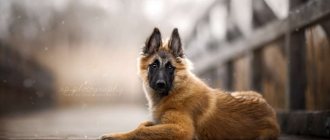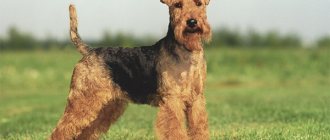Review author: “ZooVita”
Dogs that look so cute that they leave no one indifferent. The description of the French bulldog also states that pets have the peculiarity of snoring, and not only during sleep. These are very good-natured and intelligent dogs; keeping them in the house is a pleasure. The breed belongs to a number of decorative breeds, and therefore requires care and attention. More details about everything in this article.
Features of the breed: pros and cons
- Surprisingly, the ancestors of these funny dogs are molossian guard and fighting dogs.
- The French Bulldog is also called the Small Mastiff or Miniature Molosser.
- Suitable for apartment living
- Ranks 109th according to Stanley Coren's learning disability classification
- Even beginners can handle raising a French bulldog, but he is stubborn, touchy and cannot concentrate for long periods of time
- Gets along with other dogs, cats, birds
- Gentle and obedient with all family members
- Loves communication and cannot stand loneliness
- Friendly with strangers
- Doesn't require much physical activity: an hour's walk a day is enough
- Does not tolerate heat and cold well
- Due to the flattened muzzle, heart and respiratory diseases often occur.
- Not suitable for clean people: snores, passes gas and drools
- Has a sense of humor: often deliberately amuses his owners in order to console, attract attention or beg for a treat
- Knows how to “smile”: this impression is made by the special shape of the lips coupled with a perky look
- Rarely barks
- Easy to care for, but prone to many diseases: frequent examinations and treatments increase the cost of maintenance
- Included in the top 5 most allergenic breeds: owners of French bulldogs joke that they are allergic to everything, including air
Place
It is necessary to equip the puppy with a private place where he can sleep, relax and simply hide from prying eyes. The ideal place for a pet would be a spacious, moderately bright corner in a closed room, where there is not a lot of furniture and small interior items. You should not place the dog near the balcony door, on a cold tiled floor, in a draft, or in places where there is a constant flow of cold air from an air conditioner or fan - this can cause colds. You should also avoid places near radiators and other heating devices - due to constant stay in excessively warm places, the dog becomes susceptible to cold, which reduces the resistance of its body.
Breed standard
The French Bulldog standard has been revised several times. The current one, number 101, was adopted by the FCI in 2015.
The French Bulldog is a small but strong and stocky dog. The physique is dense and muscular. A snub nose and erect ears, coupled with an open and curious character, give the impression of perkiness.
Head
Square-shaped, with a flat skull, prominent forehead and prominent arches above the eyebrows. The latter form a furrow between the eyes, but it does not extend to the forehead. The head is shortened at the top.
Muzzle
Wide, square, very short. There are symmetrical skin folds on the muzzle: located on the bridge of the nose and descending along the nasolabial part.
Lips
Fleshy. The top reaches the middle of the bottom and gracefully bends from the sides. At the same time, it completely covers the fangs and incisors, but does not cover the lower lip. The border is dark.
Jaws and teeth
The jaws are square and developed. The lower one is larger than the upper one and raised: when viewed from the side, the chin is the most protruding part of the head.
Type of bite - overshot: the lower jaw overlaps the upper jaw. Full teeth are desirable.
Eyes
Round and large, slightly bulging. They stand straight and low. The color of the eyes and eyelids is dark. The look is good-natured, smart.
Nose
Snub - inclined posteriorly. The lobe is wide, flat, with well-opened and obliquely located nostrils. All dogs are colored black, regardless of color.
Ears
One of the main features of the breed is its bat-like ears. Erect, set high, wide at the base and rounded at the top. The auricle faces forward and is completely open. Soft and thin to the touch.
Neck
Shorter than the head and powerful, wider at the withers. A slight bend and no suspension are required.
Frame
Slightly stretched, with prominent muscles and strong bones. It is characterized by a low forward position: the body rises gracefully from the neck to the sacrum, so that the “Frenchman” is higher in the lower back than at the withers.
The back is wide, without deflections. The withers are pronounced, the loin is convex and shortened, the belly is tucked. The chest is voluminous, cylindrical with barrel-shaped ribs.
Limbs
The front legs are straight, parallel, with well-developed muscles. Thick and short. The shoulders are set at an angle, the wrists and pasterns are short and at an angle. The elbows are pressed to the body, directed towards the back, standing strictly under the withers.
The hind limbs are longer than the forelimbs. Well developed, muscular, with strong thighs. Placed in parallel.
Paws so-called “cat” format: small, round, with clenched fingers. The rear ones are slightly larger than the front ones. The pads are hard and black.
Tail
The French Bulldog is bobtailed from birth. The tail is set low, thick at the base and tapering towards the end. Characterized by natural fractures. Ideally, it covers the anus.
Wool
Short, close to the skin, soft and smooth to the touch. There is no undercoat.
Defects in appearance and disqualifying defects
External disadvantages of the French Bulldog breed include:
- speckled color;
- light claws;
- not black eye color;
- pincer bite;
- depigmentation of mucous membranes;
- back without lifting from front to back.
Disqualifying defects for which a French bulldog is not allowed for exhibitions and breeding:
- behavioral problems;
- unopened nostrils;
- distorted jaw;
- bite other than underbite;
- visible teeth with closed lips;
- heterochromia;
- light nose;
- drooping ears;
- not a typical tail;
- extra fingers;
- elongated, harsh or fluffy coat;
- deafness.
What is the fluffy gene in corgis?
“Fluffy” translated from English means “fluffy”, “hairy”. The presence of this gene determines the change in coat type. An allele is one of the variants of the structural states of the same gene. Different alleles can produce many variations in the information contained in that particular gene.
Long hair is not a sign of poor health, and does not prevent a dog from becoming a friend and faithful companion.
The breeder will not receive defects in the litter if the stud dogs are tested for the absence of the long hair gene.
Possible options and description of inheritance of the defective gene:
- The dog has short hair and does not carry the long hair allele. The descendants of such a dog cannot have fluffy puppies.
- The dog has short hair, carries the long allele and can pass it on to its offspring. Such dogs can give birth to puppies with either long or short hair, depending on the genotype of the second parent.
- ll. The dog has long hair and does not carry the short hair allele.
Using the table, you can understand in detail in what cases classic corgis give birth to puppies with a mutated gene, and when the breed remains pure.
| Mother | Father | Offspring |
| Standard type, not a carrier of the fluffy gene (LL) | Standard, does not carry the fluffy gene (LL) | From such parents, all puppies will be standard corgis, without marriage. |
| Standard type, carries the fluffy gene (Ll) | Standard, carries the gene (Ll) | Half of the puppies will be standard, but carriers of the defective gene. The rest: 25% obligatory fluffy, 25% standard, non-carriers. |
| Standard type, carries the gene (Ll) | Standard, does not carry the fluffy gene (Ll) | All puppies will be standard, but about a quarter of the litter will carry the gene. |
| Not a standard type, breeding marriage, carries the fluffy gene (ll) | Standard, does not carry the fluffy gene (LL) | All puppies will be carriers of the fluffy gene, with no visible signs |
| Not standard type, breeding marriage, gene carrier(ll) | Standard, carries the fluffy gene (Ll) | Half of the puppies will have obvious signs of flaffy, half will be standard, but carriers of the gene. |
| Mother and father are not a standard type, they have a breeding marriage - the presence of the gene (ll) | All puppies will have long hair. | |
Puppies with the fluffy gene in Welsh Corgi type ll are not allowed for breeding and are not suitable for participation in exhibitions.
Colors from photos
Although you can find French Bulldogs in a variety of colors, the standard allows only three varieties: brindle, fawn and spotted. All colors with photos and their subspecies are described below.
Brindle (Brindle)
It is formed by alternating stripes. Color varies from wheaten with dark areas to almost black with isolated red hairs.
Fawn (Fauve)
Varies from light biscuit to deep red. There are two types:
- Single color (fawn). The color of the coat is any range of fawn: from gray-milky to bright red.
- With brindle or streaks (brindle). On the main background there are dark transverse stripes. Their number and thickness vary: from single thin to a large number of darkened areas. Similar to brindle, but genetically they are different colors.
Additional Information! With brindle and fawn colors, small light spots on the chest and head, as well as a mask on the face, are acceptable.
Spotted (Caille)
Characterized by the arrangement of colored spots on a white background. It is formed with increased piebaldity: when light areas displace dark ones. There are two types of suit:
- White spots alternate with brindle: white & brindle.
- White areas alternate with fawn: white & fawn.
Sometimes in spotted French bulldogs the white color is so dominant that it displaces all colored areas. Visually, it seems that such dogs are snow-white. In reality, this is not the case: only the fur lacks pigment, and there are noticeable dark spots on the skin.
Vaccinations
| Age | Graft |
| 30 days (optional vaccination) | Nobivac Puppy DP – vaccine against canine distemper and parvovirus enteritis |
| 8 weeks | Nobivac DHPPi + Lepto – against canine distemper, infectious hepatitis, parvovirus enteritis, parainfluenza and leptospirosis |
| 10 - 12 weeks | Nobivac DHPPi + Lepto + Rabies – against canine distemper, infectious hepatitis, parvovirus enteritis, parainfluenza, leptospirosis, rabies |
| 7 - 8 months (after changing teeth) | DHPPi + Lepto – against canine distemper, infectious hepatitis, parvovirus enteritis, parainfluenza and leptospirosis |
Only an absolutely healthy dog can be vaccinated; deworming must be carried out 10 - 14 days before the procedure.
French Bulldog weight by month
When assessing the development of a French Bulldog, the key focus is on weight rather than height. Puppies grow actively until 6-7 months, after which they gain weight until 9-12 months. From one year on, growth stops, but dogs continue to build up their muscles and are fully formed until they are two years old.
The height standard for adult males is 27-35 cm, for females - 24-32 cm. The weight standard is 9-14 kg and 8-13 kg, respectively.
Below is a table with average weights by month for French Bulldog puppies:
| Age | Weight (in kg) |
| At birth | 0,2—0,3 |
| 4 weeks | 1—1,5 |
| 2 months | 2—2,5 |
| 3 months | 3,2—5 |
| 4 months | 4—6,5 |
| 5 months | 4,8—7,8 |
| 6 months | 5,6—9,1 |
| 7 months | 6,4—10,4 |
| 8 months | 7,2—11,7 |
| 9 months | 8—13 |
| 10-12 months | 8—14 |
The values given are approximate. Males and females of the French Bulldog breed develop differently, and even same-sex puppies from the same litter may have different parameters. Therefore, when growing, focus more on how balanced the baby’s overall appearance is and how he feels.
Puppy cost
The Bulldog is not a rare breed, so finding a seller is easy. Without documents and a guarantee of purebredness, you can purchase a puppy for a small price. However, it is better to take a bulldog from a professional kennel.
This is interesting: 10 most inexpensive dog breeds
The following rates for dogs are possible:
- 3000 rub. Most often, this is the price for puppies that are sold by ordinary owners of the bitch that gave birth. There is no guarantee that the baby will grow into a dog of the required height, weight, or color.
- A puppy without a pedigree in a professional nursery will cost an average of 10-20 thousand rubles.
- A bulldog with all the necessary documents costs from 20 to 80 thousand.
Personality of the French Bulldog
From their ancestors - mastiff-like dogs and English bulldogs - French bulldogs inherited a powerful physique, insensitivity to pain and fearlessness. Therefore, dogs are always ready to defend themselves and their owner. They are also good watchmen: they warn of the appearance of strangers with a ringing bark.
But the “French” also has the blood of good-natured pugs. Therefore, dogs are gentle, loyal and playful companions. They easily find language with all people. But they are especially affectionate and affectionate with family members.
The breed has a sociable character. Bulldogs do not leave their owners all day long, they are always happy to play and fool around. And they cannot stand loneliness. If you leave your pets alone for several hours, they express their fear of separation into destructive behavior: they throw things around, chew furniture, floors, wallpaper, and doors.
French Bulldog puppies are especially sociable and playful. After two years, dogs become more imposing, and their behavior becomes calm and measured. But until old age, French bulldogs do not lose their perky disposition.
French bulldogs get along well with children. But they are not always patient with kids: they can snap or bite in response to rough games. Therefore, it is better for families with schoolchildren to have pets and explain to the children how to treat animals correctly: do not bully them, do not take away toys and food. Newborn pets may become jealous because babies receive a lot of attention.
French bulldogs prefer to be the only pets in the family. They are jealous. But they get along with other dogs and cats if they recognize their dominance, and the owners pay enough attention to all animals.
Bulldogs often conflict with other people's pets. Not averse to fighting with other dogs, even if they are several times larger than them. And cats walking on the street are chased away.
This is interesting! The “French” subtly sense the mood of the owner. If he is cheerful, the pets start playing games. If she’s sad, they sit down next to you, look carefully and perk up their locator ears to “listen.” Bulldogs also have a great sense of humor: that’s why they often deliberately amuse people with their antics.
Miniature Bulldogs are excellent companions for singles, families and seniors. But they are not suitable for those who work a lot and are not at home for a long time. Dogs need constant communication and close contact with humans.
Reviews
“This is an exclusively apartment breed; it cannot be kept in an enclosure - the baby freezes quickly. At home, the bulldog produces a lot of drool and fine hair. The dog is not a guard, he loves to play with children and entertain guests.”
“The bulldog grunts cutely in his sleep. It's impossible not to fall in love with a funny face. When guests arrive, all attention is paid to the “Frenchman”. The dog's temperament is stubborn, but it can be taught commands. The main thing is to gain authority and sympathy from this creature.”
“A loving miracle, he prefers to sleep with his owner in the same bed. You don’t have to walk your dog for a long time; 10 minutes is enough. The bulldog likes to jump in the snow, but does not tolerate frost well. Sleeping on a warm bed or chewing on toys is his favorite thing.”
Care and maintenance
French bulldogs feel equally good in a city apartment and a private house. But they cannot be kept outside in an enclosure. These are lap dogs. They love comfort and cannot stand heat or cold.
Hygiene
Caring for French bulldogs is not difficult. The dogs are short-haired, shed a lot of hair only during shedding, they do not need to be cut and bathed frequently. But you will still need to regularly carry out hygiene procedures:
- Bathing. Bulldogs are washed no more than once a month. Otherwise, the skin will become dry, the coat will become dull and brittle, and dandruff will appear. To remove dirt after a walk, wipe the paws and underbelly with a damp sponge. After bath procedures, the pet is thoroughly dried with a towel, not allowed outside for a couple of hours and drafts are avoided.
- Combing. Brush 1-2 times a week to remove dead hairs, dust and distribute sebum throughout the coat. During the molting period, the number of procedures is doubled. Use a soft brush for short-haired breeds or a comb-mitten.
- Caring for skin folds on the face. Dirt, leftover food and water constantly accumulate in them, and they rot. Therefore, every day the muzzle is wiped with a soft cloth.
- Ear cleaning. Due to their structure, French Bulldogs' ears tend to accumulate little wax. But dirt and mites often get into them, and inflammation is common. Therefore, the ears are inspected every day and cleaned once a week. Use a sponge soaked in veterinary lotion or chlorhexidine.
- Teeth cleaning. Teeth are the weak point of the French. They often wear down, break, and plaque quickly accumulates on them. Brush and use dog paste once a week. The rest of the time they give toothpicks treats.
- Cleaning the eyes. Due to the fact that French Bulldogs have slightly bulging eyes, they often become inflamed and injured. Every day, the nitrous is carefully removed and examined for diseases.
- Nail trimming. If a dog walks on the asphalt for a long time every day, the claws wear down on their own. But in most cases, they are trimmed with a nail clipper, and then the sharp edges are smoothed with a nail file. The procedure is carried out once a month.
Toilet
In the first weeks after the puppy appears in the house, he is taught to walk on a newspaper or diaper in the house. At this time, quarantine after vaccinations is still in effect, so you cannot take your baby outside.
The puppy is trained to use the house toilet from 2-3 months: until this age, the kittens cannot control themselves. The floor is covered with newspapers or diapers: in places where the baby often gets things done. Gradually they are shifted towards one side: to where the pet will go constantly.
After the vaccine quarantine is lifted, the puppy begins to be taken outside. They do this every two hours: after sleeping, playing, eating. If you do the right thing, you will be praised.
Advice! It is advisable to guide your pet along the same route: the smell of previous marks will tell him what to do. If your pet does not defecate outside for a long time, take water and food with you. After feeding and playing, the puppy will definitely want to go to the toilet.
French bulldogs are smart and easily learn to relieve themselves in the tray and even in the toilet. This quality comes into play when the dog cannot be taken outside due to bad weather, after vaccination, or during illness.
To do this, they resort to the same tactics as with puppies. Spread the diapers in several places and gradually move them towards the tray. The potty is covered with a moisture-absorbing diaper or newspapers: cat litter is not suitable.
If they notice that the dog is defecating in the wrong place, they immediately scold him loudly and take him to the tray so that he finishes his business there. But this must be done at the moment of the “crime”, otherwise the dog will not understand why he is being reprimanded.
In other cases, “unauthorized” piles and puddles are simply removed. Dirty areas are rubbed with vinegar or a special odor remover. Do not use bleach or substances with ammonia: they smell like urine.
Feeding
Read the separate article What to feed your French Bulldog.
How long French bulldogs live is directly affected by the quality of their diet. The breed is prone to allergies, obesity and digestive diseases. Therefore, natural diets are carefully prepared, and holistic or super-premium brands are selected from ready-made food.
- Rating of holistic dog food
- Rating of super-premium food for dogs
If you plan to feed “natural”, the menu consists of:
- lean meats: turkey, veal, rabbit, chicken (the latter causes allergies in some animals);
- offal: hearts, lungs, stomachs, liver (in limited quantities);
- porridge: wheat, buckwheat, rice, oatmeal;
- fermented milk products: kefir, cottage cheese, yogurt without additives;
- seasonal vegetables and fruits.
French bulldogs are prohibited from feeding fatty meats, sweets, cheeses, legumes, mushrooms, processed foods, fried and smoked foods with seasonings. Milk causes diarrhea in adult pets.
Decorative bulldogs are still beggars. They will constantly beg for tasty “harmful things”. Do not fall for pitying glances and touching faces. Remember that even a few bites of illicit food can cause serious illness and death.
Among industrial feeds, veterinarians recommend the brands Acana, Oridjen, Grandorf, GO!, Dukes Farm. Choose lines for small breeds, dogs with allergies and those with sensitive digestion.
A place for eating is set up in a secluded place. Bowls are chosen with a stand and placed at the height of the dog’s chest. Food is served at room temperature. Bottled water should always be freely available: change it several times a day as it gets dirty.
Feeding regimen depends on age:
- up to 2 months - 6 times a day;
- at 3 months - 5 times a day;
- from 4 to 7 months - 4 times;
- at 8-12 months - 3 times;
- Dogs older than one year are fed twice a day.
Veterinarians recommend that French bulldogs be weighed regularly. This is how the puppies develop. And in adult dogs, it helps detect excessive weight gain at an early stage.
Walks and trips
One of the advantages of the breed is that it does not need long walks; the disadvantages are that the “Frenchies” do not tolerate heat and cold well. Therefore, you will need special clothing for walks.
Decorative bulldogs do not need to be walked often or for a long time: 20 minutes in the morning and about an hour in the evening is enough. But this does not mean that they do not need to be taken outside at all. Like any dog, Frenchies need walks, games, and jogging. Moreover, the breed is prone to obesity.
Bulldogs run with pleasure, fetch a ball and Frisbee, and play with a stick. They involve everyone around them in the noisy fuss: other dogs, children and adults. But you need to make sure that the dogs do not overwork: due to their flattened muzzle, they quickly develop shortness of breath.
In summer, when going for a walk, take water, a damp towel, and you can put on a cooling blanket. Do not stay in the sun for a long time and do not take your pet out during the day in the heat of the day. During the cold season, the French bulldog is dressed in warm clothes. If it's raining outside, use waterproof overalls.
Miniature Bulldogs love to travel. They can be transported by car, bus, train. But remember about intolerance to heat: air conditioning in transport is desirable. They also take a lot of water and give the pet food often.
Important! French bulldogs are prohibited from being transported by plane: due to the brachycephalic shape of the skull, there is a high risk of death.
Animal breeding
The body structure of male dogs makes natural insemination of a female dog problematic, so for greater guarantee, breeders often resort to artificial insemination.
Due to the puppies' disproportionately large heads and narrow hips, Frenchie bitches are rarely able to give birth on their own; more often they require a caesarean section.
It would not be superfluous to conduct an ultrasound to clarify the number of puppies and their location. It is especially important to know this if labor attempts stop and dead puppies remain in the uterus.
Pregnancy lasts about 63 days, sometimes labor begins earlier or later.
IMPORTANT!
Lack of help during contractions that suddenly begin can lead to the death of the bitch.
Education and training
French Bulldogs are not the smartest dogs: they are ranked 109th in Stanley Coren's classification. But they are highly human-oriented, so they easily pass the general training course, the “Controlled City Dog” qualification, and master agility, freestyle and other types of canine sports quite well.
Raising a puppy begins from the first day of life in a new home. He needs to be immediately shown places to rest, play, eat, and use the toilet. The commands “Fu”, “No”, “Come to me” are gradually taught. Even kids quickly remember them.
All commands learned at home must be practiced outside: the dog must carry them out in different places and circumstances. The breed is somewhat stubborn, often distracted and quickly tired of monotonous repetitions. Therefore, classes are kept short and alternated with games and walks.
Important! Cruelty and rudeness in education are prohibited. Bulldogs are somewhat touchy, although not vindictive. Like any breed, they learn better from a reward system: try to praise the animal more often than to scold it.
After the vaccine quarantine is lifted, the dog begins to be socialized. She is introduced to other pets and children, taken to different places (parks, shops, noisy crowds), and taught to ride public transport.
French bulldogs are easy-going and strive to please their owner. Even a novice dog breeder can handle their training. But if this is your first dog, it is advisable to attend classes with a dog trainer. He will tell you how to properly raise your pet, teach you to understand the animal and help you learn basic commands.
Health and illness
The French Bulldog is a breed of artificial selection. Therefore, they are prone to many diseases. The average life expectancy does not exceed 10-12 years with good care. Some representatives lived up to 14-15 years, but this is a rare exception.
Common diseases in the breed include:
- deformation of the soft palate;
- joint dysplasia: knee and hip;
- allergies;
- diseases of the cardiovascular system;
- pathologies of intervertebral discs;
- blood diseases;
- obesity;
- dermatitis of skin folds on the face or between the fingers;
- eye pathologies: glaucoma, third eyelid, conjunctivitis, cataract, entropion, blepharitis;
- urolithiasis disease;
- hypotrichosis - symmetrical hair loss.
Important! Due to the tendency to numerous diseases, the American Kennel Club recommends that before purchasing a puppy, check with the parents for certificates of absence of problems with vision, joints and heart.
In addition to hereditary diseases, the breed also has health characteristics associated with physique:
- complicated mating: “hand” mating is often practiced;
- obstructed childbirth: in most cases, a cesarean section is performed;
- problems with thermoregulation: dogs tolerate heat and cold equally poorly;
- susceptibility to colds and respiratory pathologies: due to the flattened muzzle.
Rules for choosing puppies
It is recommended to purchase babies of this breed from kennel clubs. The likelihood of buying a purebred and healthy bulldog is higher there. It is better to visit several nurseries.
The enclosure itself, in which the dogs are kept, is also worth a look. It should at least be clean.
If the conditions of detention are satisfactory, then you can request information about the bulldog you like: heredity, information about parents, character traits.
Expert opinion
Anna Abramenko
An avid dog lover. Experience in veterinary medicine since 2009.
Ask a Question
You need to purchase a puppy of this breed at the age of 6-8 weeks.
You can determine whether your baby is healthy by the following signs:
- the coat is clean and shiny;
- the body is strong;
- paws are strong, developed;
- skin without scratches or redness;
- pink gums;
- ears and eyes are clean;
- nose wet and cold;
- paw pads are soft;
- teeth are white.
By observing the behavior of puppies, they determine which character traits and features predominate in them. As a rule, bulldogs do not change as they grow older. You can note the calm disposition of the baby or the restlessness, angry and timid behavior of the puppy.
If you have no previous experience of keeping a dog, and now you have a choice between a boy and a girl, then it is better to take a bitch. They are more flexible, learn faster and become attached to the owner and try less to take a dominant position.
